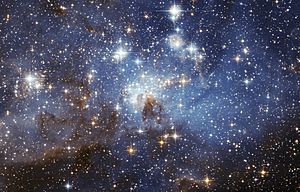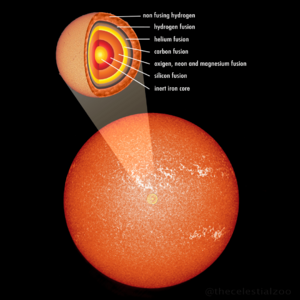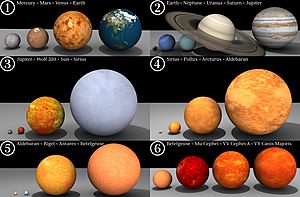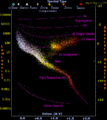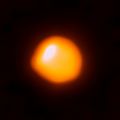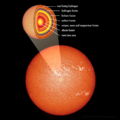Star facts for kids
A star is a giant ball of super hot gas called plasma. It's held together by its own strong pull, called gravity. Stars create and release a lot of energy because of special reactions happening deep inside them.
This energy comes out as heat and light. Stars also give off other types of energy like radio waves, micro-waves, X-rays, gamma-rays, and ultra-violet light. The type of energy a star gives off depends on how big it is and how old it is.
The energy in stars comes from a process called nuclear fusion. This is when light elements combine to form heavier ones. Stars are mostly made of hydrogen and helium. They turn hydrogen into helium through fusion. When a star gets older, it starts turning helium into even heavier elements like carbon and oxygen. Fusion makes a huge amount of energy, which makes the star very hot and bright.
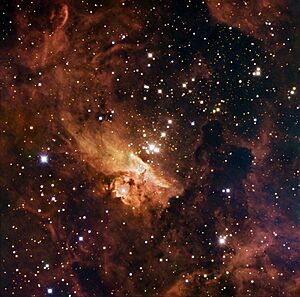
The strange shapes of the gas clouds are caused by the huge amount of energy coming from these massive, hot stars.
This picture combines images taken with different light filters from a telescope in Chile.
Contents
How a Star is Born
A star starts as a big cloud of gas, mostly hydrogen, with some helium and tiny bits of heavier elements. This cloud slowly pulls together because of gravity. As it gets denser, the center becomes hot enough for nuclear fusion to begin. This is when hydrogen starts turning into helium.
The energy created moves out from the center of the star. Young stars that are smaller than about 2 times the Sun's mass are called T Tauri stars. Bigger young stars are called Herbig Ae/Be stars.
The Main Life of a Star
Stars spend most of their lives, about 90%, turning hydrogen into helium in their hot, dense centers. Stars in this stage are called "main sequence" stars or dwarf stars. Our Sun is a main sequence star.
As a star fuses hydrogen, the amount of helium in its core slowly grows. This makes the fusion process a bit faster, and the star gets a little hotter and brighter over time. For example, our Sun has become about 40% brighter since it started its main sequence life 4.6 billion years ago.
Stars also constantly lose a tiny bit of gas into space, called a stellar wind. For most stars, this loss is very small. The Sun loses a tiny amount of its mass each year, which is only about 0.01% of its total mass over its whole life. However, very big stars can lose a lot more mass, which changes how they grow and age.
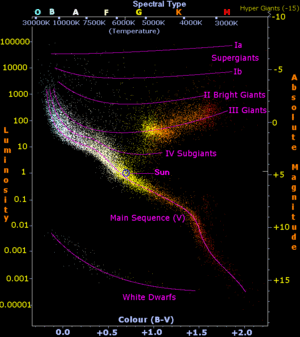
How long a star stays on the main sequence depends on how much fuel it has and how fast it uses it. Our Sun is expected to live for about 10 billion years. Very big stars use up their fuel quickly, so they don't live as long. Small stars, like red dwarfs, use their fuel very slowly. Stars that are less than a quarter of the Sun's mass can live for trillions of years. This is much longer than the current age of the universe (about 13.8 billion years)!
Besides mass, the amount of elements heavier than helium (which astronomers call "metals") can also affect a star's life. Stars with more "metals" might burn their fuel differently. Older stars have fewer "metals" than younger ones because the clouds they formed from weren't as rich in these elements. Over time, as old stars die, they release heavier elements into space, enriching the gas for new stars to form.
What Happens After the Main Life
When stars that are at least 0.4 times the Sun's mass run out of hydrogen in their core, they start fusing hydrogen in a shell around the core. This makes the star's outer layers expand and cool down a lot, turning it into a red giant.
Sometimes, these stars will also start fusing heavier elements in their core or in shells around it. As they expand, they push some of their outer material, now rich with these new elements, out into space. This material can then be used to form new stars later. In about 5 billion years, our Sun will become a red giant. It will expand so much that it will reach beyond Earth's orbit, becoming 250 times its current size, and it will lose about 30% of its mass.

After a star uses up the helium in its core, it starts fusing helium in a shell around a hot carbon core. During this phase, the star's brightness changes, and it throws off more material from its outer layers. This material forms a beautiful cloud called a planetary nebula. A star can lose up to 50% or 70% of its mass this way. The material in the planetary nebula is rich in elements like carbon and oxygen. Eventually, the nebula spreads out, adding these elements to the gas and dust between stars. This means that future stars are made from the "star stuff" of old stars!
Life of Massive Stars
Very massive stars (more than 9 times the Sun's mass) expand to become blue and then red supergiants during their helium-burning phase. Some extremely massive stars can even become Wolf–Rayet stars.
When a massive star runs out of helium in its core, the core shrinks. The temperature and pressure get high enough to start fusing carbon. This process continues, with the star fusing heavier elements like neon, oxygen, and silicon in different layers, like an onion. The outermost layer still fuses hydrogen, the next fuses helium, and so on.
The final stage happens when a massive star starts making iron. Iron nuclei are very stable, so fusing iron doesn't release energy. Instead, it takes energy. This means the star can no longer support itself.
How Stars Die
As a star's core shrinks, the energy coming from it becomes so strong that it pushes away the outer layers of gas, forming a planetary nebula. If the remaining core is less than about 1.4 times the Sun's mass, it shrinks into a very small object, about the size of Earth, called a white dwarf. White dwarfs don't have enough mass to keep collapsing. The material inside a white dwarf is no longer plasma. Over a very long time, white dwarfs slowly cool down and fade into black dwarfs.
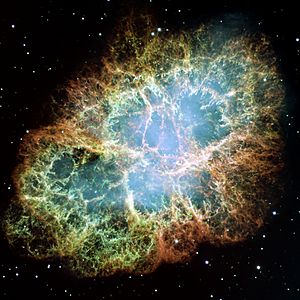
In very massive stars, fusion continues until the iron core becomes too big (more than 1.4 times the Sun's mass) to support itself. This core suddenly collapses. Its electrons are forced into its protons, creating neutrons and a huge burst of energy. The shockwave from this collapse causes the rest of the star to explode in a supernova. Supernovae can become so bright that they briefly outshine an entire galaxy! When they happen in our Milky Way galaxy, people used to see them as "new stars" appearing in the sky.
A supernova explosion blows away the star's outer layers, leaving behind a supernova remnant like the Crab Nebula. The core is crushed into a neutron star. Sometimes, these neutron stars spin very fast and send out beams of energy, becoming pulsars. If the original star was extremely massive, the leftover core becomes a black hole that is more than 4 times the Sun's mass.
The outer layers blown off by dying stars contain heavy elements. These elements can then be used to form new stars and even rocky planets. The gas and energy from supernovae and stellar winds also help shape the gas and dust between stars.
Our Earth and the Sun
The closest star to Earth is the Sun. The energy from sunlight helps almost all life on Earth through photosynthesis. It also drives Earth's climate and weather. Earth also has its own heat inside, which comes from when it first formed and from radioactive materials deep within it.
At night, when the Sun sets, we can see other stars in the sky. They are also mostly made of hydrogen and helium, just like our Sun.
Stars and Planets
Most stars look like tiny, shiny dots from Earth because they are incredibly far away. Our Sun is the closest star to us. Earth and other planets move around (or orbit) the Sun. The Sun and everything that orbits it is called the Solar System. Many other stars also have planets orbiting them. These are called exoplanets.
How Many Stars? How Far?
The closest star to our Solar System, besides the Sun, is Proxima Centauri. It's about 39.9 trillion kilometres away. This is about 4.2 light years. A light-year is the distance light travels in one year. So, light from Proxima Centauri takes 4.2 years to reach Earth!
Astronomers believe there are a huge number of stars in the Universe. They guess there are at least 70 sextillion stars. That's 70 followed by 21 zeros (70,000,000,000,000,000,000,000)! This is about 230 billion times the number of stars in our own Milky Way galaxy.
Most stars are very old, usually between 1 and 10 billion years old. The oldest stars are thought to be around 13.7 billion years old, which is close to the age of the Universe itself.
Stars come in many different sizes. The smallest neutron stars (which are actually dead stars) are no bigger than a city. Neutron stars are incredibly dense. If you could take a tiny piece, just a micrometer thick, and put it on a tank, the tank would become so heavy it would sink into the center of the Earth!
Hypergiant stars are the largest stars in the Universe. They can be over 1,500 times bigger than the Sun. If our Sun were replaced by one of these huge stars, its outer edge would reach past the orbit of Jupiter, and Earth would be inside the star! The star Betelgeuse, in the Orion constellation, is a red supergiant star.
When we look at the night sky without a telescope, some stars look brighter than others. This is called their apparent magnitude. There are two main reasons for this difference. First, a star that is closer to us will look brighter, just like a nearby candle looks brighter than a big fire far away. Second, a star that is much larger or hotter will look brighter, even if it's the same distance away. A star's true brightness is called its absolute magnitude.
Besides light, stars also give off a solar wind and tiny particles called neutrinos.
Stars create a strong gravity field. This is what keeps planets orbiting them. It's also common for two stars to orbit each other. This happens when they are close together, similar to how Earth orbits the Sun. These binary stars (meaning "two") are very common. There are even groups of three or more stars orbiting each other. Proxima Centauri, for example, is the smallest star in a group of three.
Stars are not spread out evenly in space. They are grouped together into huge collections called galaxies. A typical galaxy has hundreds of billions of stars.
History of Looking at Stars
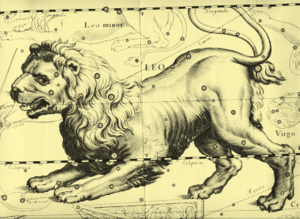
Stars have been very important to people all over the world throughout history. Stars were part of religious practices. Long ago, people thought stars could never die. Astronomers grouped stars into patterns called constellations. They used these constellations to track the movement of planets and to guess the Sun's position. The movement of the Sun and stars helped people create calendars. Farmers used these calendars to know when to plant and harvest their crops.
Colors of Stars
Astronomers have known for hundreds of years that stars have different colors. When we look at the electromagnetic spectrum, ultraviolet waves are the shortest, and infrared waves are the longest. The visible spectrum (the light we can see) is in between these two.
Modern tools can measure a star's color very accurately. This helps astronomers figure out a star's temperature. Hotter stars give off shorter wavelengths of light, which appear blue or violet. The hottest stars are blue and violet, then white, then yellow, and the coolest stars are red. Knowing a star's color and its true brightness (absolute magnitude), astronomers can place it on the Hertzsprung-Russell diagram. This helps them estimate things like its habitable zone (where planets could have liquid water).
For example, our Sun is a white star, and Earth is at just the right distance for life to exist. If our Sun were a hotter, blue star, Earth would have to be much farther away, or it would be too hot for water and life.
Images for kids
-
Infrared image from NASA's Spitzer Space Telescope showing hundreds of thousands of stars in the Milky Way galaxy
-
An example of a Hertzsprung–Russell diagram for a set of stars that includes the Sun (center)
-
Betelgeuse as seen by ALMA. This is the first time that ALMA has observed the surface of a star and resulted in the highest-resolution image of Betelgeuse available.
-
Artist's impression of the Sirius system, a white dwarf star in orbit around an A-type main-sequence star
-
This view of NGC 6397 includes stars known as blue stragglers for their location on the Hertzsprung–Russell diagram.
-
The Pleiades, an open cluster of stars in the constellation of Taurus. These stars share a common motion through space.
-
The reflection nebula NGC 1999 is brightly lit by V380 Orionis. The black patch of sky is a vast hole of empty space and not a dark nebula as previously thought.
-
The asymmetrical appearance of Mira, an oscillating variable star
-
A cross-section of the Sun
See also
 In Spanish: Estrella para niños
In Spanish: Estrella para niños


